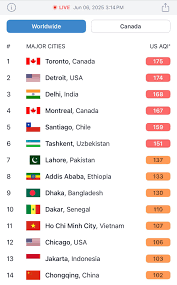Understanding Air Quality in Toronto: What You Need to Know

Introduction
Air quality is a pressing public health concern, especially in urban centers like Toronto. With increasing urbanization, pollution from vehicles, industries, and residential heating are significant contributors to air quality issues. In a city like Toronto, understanding air quality is paramount for the well-being of its citizens and the broader ecosystem. Recent events, including wildfires and industrial emissions, have significantly affected air quality levels, making it a topic of relevance for all residents.
The Current State of Air Quality in Toronto
As of late 2023, air quality in Toronto has displayed fluctuations primarily influenced by regional wildfire smoke, combined with local emissions. The Air Quality Index (AQI) often reflects levels ranging between “moderate” and “unhealthy for sensitive groups” depending on prevailing weather conditions. According to recent reports from Environment Canada, harmful particulate matter reached concerning levels during hot weather, compounded by drought conditions in surrounding areas that heightened wildfire activity.
In September 2023, an unprecedented series of forest fires in Northern Ontario resulted in smoke engulfing Toronto, causing temporary deterioration in air quality. Emergency alerts were issued signaling elevated health risks, particularly for those with pre-existing respiratory conditions. This incident highlights the vulnerability of urban areas to environmental factors beyond their immediate control.
The Causes of Poor Air Quality
Toronto’s air quality is predominantly affected by various factors:
- Vehicle Emissions: Traffic congestion contributes significantly to the accumulation of nitrogen oxides and particulate matter.
- Industrial Emissions: Factories and industrial sites around the Greater Toronto Area (GTA) release pollutants that can migrate into urban air.
- Climate Change Effects: Increased temperatures have been linked to heightened ozone levels, which can exacerbate health risks.
Measures for Improvement
In response to these challenges, the City of Toronto has initiated several measures aimed at improving air quality. Strategies include the promotion of public transportation and cycling, imposing stricter regulations on industrial emissions, and increasing green spaces to mitigate pollution effects. The city has also invested in community awareness campaigns to educate residents on air quality and suggested precautions during poor air quality days.
Conclusion
The significance of monitoring air quality in Toronto cannot be understated. Continued vigilance and proactive measures will be crucial for improving urban air conditions and protecting public health. As the city’s climate adaption strategies evolve, residents can expect ongoing efforts by the government and local organizations to combat the pollutants that threaten their well-being. Keeping informed about air quality indices and following advisories can empower individuals to make healthier decisions for themselves and their families.









